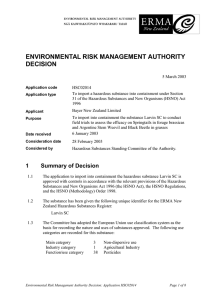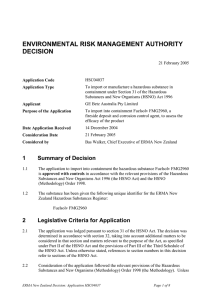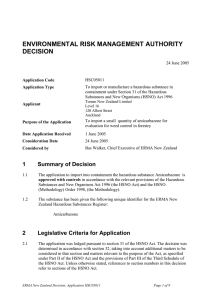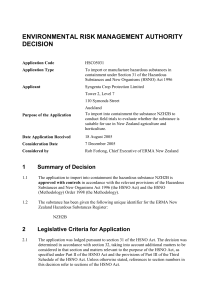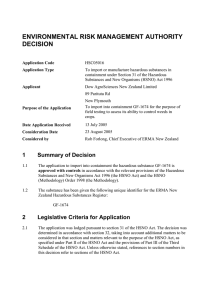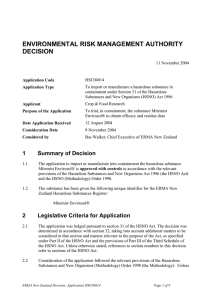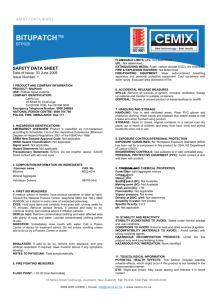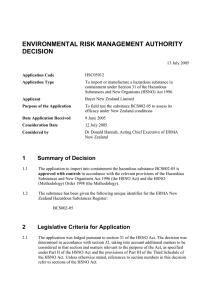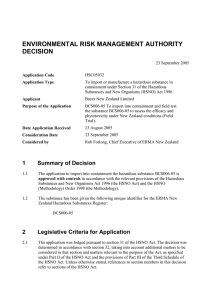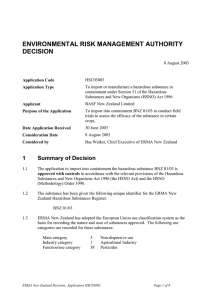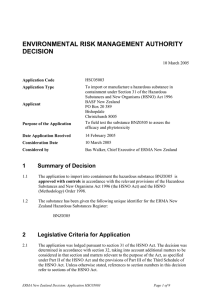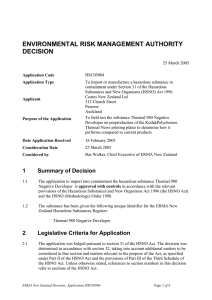environmental risk management authority decision
advertisement
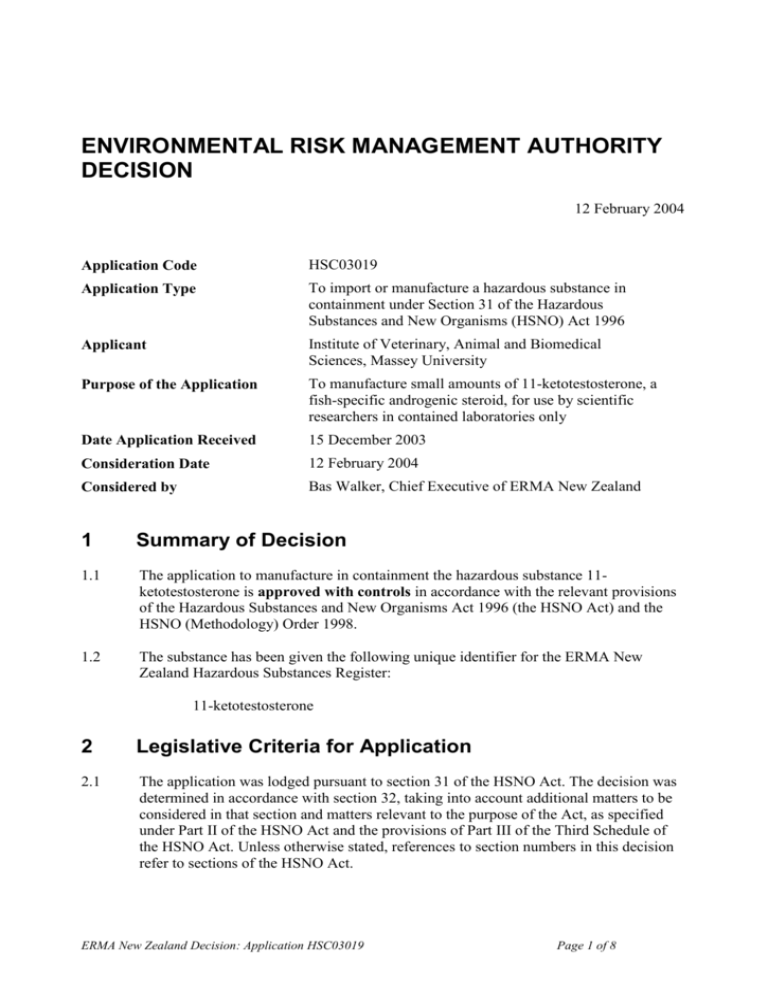
ENVIRONMENTAL RISK MANAGEMENT AUTHORITY DECISION 12 February 2004 Application Code HSC03019 Application Type To import or manufacture a hazardous substance in containment under Section 31 of the Hazardous Substances and New Organisms (HSNO) Act 1996 Applicant Institute of Veterinary, Animal and Biomedical Sciences, Massey University Purpose of the Application To manufacture small amounts of 11-ketotestosterone, a fish-specific androgenic steroid, for use by scientific researchers in contained laboratories only Date Application Received 15 December 2003 Consideration Date 12 February 2004 Considered by Bas Walker, Chief Executive of ERMA New Zealand 1 Summary of Decision 1.1 The application to manufacture in containment the hazardous substance 11ketotestosterone is approved with controls in accordance with the relevant provisions of the Hazardous Substances and New Organisms Act 1996 (the HSNO Act) and the HSNO (Methodology) Order 1998. 1.2 The substance has been given the following unique identifier for the ERMA New Zealand Hazardous Substances Register: 11-ketotestosterone 2 Legislative Criteria for Application 2.1 The application was lodged pursuant to section 31 of the HSNO Act. The decision was determined in accordance with section 32, taking into account additional matters to be considered in that section and matters relevant to the purpose of the Act, as specified under Part II of the HSNO Act and the provisions of Part III of the Third Schedule of the HSNO Act. Unless otherwise stated, references to section numbers in this decision refer to sections of the HSNO Act. ERMA New Zealand Decision: Application HSC03019 Page 1 of 8 2.2 Consideration of the application followed the relevant provisions of the Hazardous Substances and New Organisms (Methodology) Order 1998 (the Methodology). Unless otherwise stated, references to clauses in this decision refer to clauses of the Methodology. 3 Application Process 3.1 The application was formally received on 15 December 2003 and assessed as having sufficient information on 16 December 2003. 3.2 Project Team: Beth Dye Applications Advisor (Hazardous Substances) Linda Robinson Senior Advisor (Māori Affairs) Report review and sign-out by: Ted Taylor Programme Manager (Applications) 3.3 The applicant supplied the following documents: The application, including non-confidential appendices comprising a reference list, proposed label and proposed MSDS A confidential appendix, containing commercially sensitive information. 3.4 The following Government departments were advised of the receipt of the application (in accordance with clause 2(2)(e)) and given the opportunity to comment: The Ministry of Health The Department of Labour (Occupational Safety and Health) The New Zealand Food Safety Authority (Agricultural Compounds and Veterinary Medicines Group (ACVM Group)). 3.5 A response was received from The Ministry of Health, stating that with appropriate HSNO controls, the Ministry has no issues to raise at this time relating to the acceptance of this application based on non-confidential information provided from a public health perspective (nonoccupational) given that the substance will be limited for research purposes only. 3.6 The applicant was provided with a copy of the proposed controls for 11ketotestosterone and given the opportunity to comment on them. Several questions were raised and answered, and the applicant had no further issues with the proposed controls. ERMA New Zealand Decision: Application HSC03019 Page 2 of 8 4 Consideration Sequence of the Consideration 4.1 This application was considered by the Chief Executive of ERMA New Zealand under delegated powers from the Authority (section 19(2)(e) of the HSNO Act). 4.2 In accordance with section 32 of the Act, the approach adopted when considering this application was to confirm whether the application was for one of the purposes specified in section 30, to identify and assess the risks and to determine whether the substances could be adequately contained by controls to provide for each of the matters specified in Part III of the Third Schedule of the Act. Purpose of the Application 4.3 The purpose of the application is to manufacture small amounts of 11-ketotestosterone, a fish specific androgenic steroid, for sale to scientific researchers who will use it for research purposes in contained laboratories only. 4.4 As the purpose amounts to “research and development on any hazardous substance”, I consider that the application qualifies for consideration under section 30(ba) of the Act. Hazardous Properties 4.5 I note that a containment application only requires sufficient understanding of the hazardous properties to ensure that any risks can be managed by the containment controls. 4.6 The applicant has searched the available literature and has found no specific information on the substance. The applicant has therefore considered possible hazardous properties by comparison with other steroids and has identified that the hazardous properties of 11-ketotestosterone are likely to be limited to toxic (carcinogenic, reproductive/developmental and target organ/systemic) and ecotoxic (aquatic) properties. 4.7 I have reviewed the applicant’s hazard information. This is insufficient to fully describe the hazards of the substance but provides a workable basis for setting the containment controls to ensure that any risks can be adequately managed. Life Cycle 4.8 11-ketotestosterone will be synthesised in quantities totalling 10-20 grams per year in the Nanomaterials Enterprises Laboratory, Institute of Fundamental Sciences, Massey University. In each batch, 1 gram of the substance will be manufactured and it will be stored in a secure locked facility prior to sale to research laboratories mainly in North America, Japan and Europe. The scientific researchers in these laboratories will be primarily investigating fish reproductive physiology. Relevant information for the enduser will be contained in the Safety Data Sheet supplied with each batch. ERMA New Zealand Decision: Application HSC03019 Page 3 of 8 Identification and Evaluation of the Significant Risks of the Substance in Containment 4.9 In accordance with sections 5, 6, and 8 and clauses 9 and 11, I considered the potential risks of escape from containment under the headings of environmental, human health and welfare and Māori issues and concerns. 4.10 In the application, the applicant identified and assessed potential risks, and detailed proposals for, and impacts of risk management. I have reviewed the applicant’s assessment of risks and agree that it is suitable for the consideration below. Risks to the Environment 4.11 No ecotoxicological data are available on the substance. The applicant has indicated that the substance may be classified as 9.1C, as some steroids disrupt the development of aquatic invertebrates. 4.12 On the basis of the lifecycle of the substance outlined in paragraph 4.8, adverse effects could arise from: An accident during manufacture, use or transportation, resulting in release of the substance Failure to follow correct disposal procedures as outlined in the Safety Data Sheet. 4.13 I note that the quantities involved are very small (a total of 10-20g per year with individual batches of 1g). 4.14 I consider that, taking into account the properties of the substance, the quantity involved, the containment controls in Appendix 1 and controls in place under other legislation, there are no significant risks to the environment. Risks to Human Health and Welfare 4.15 No toxicological data are available on the substance. The applicant has indicated that the substance may be classified in the 6.7, 6.8 and 6.9 classes, as some steroids may cause carcinogenic or teratogenic effects, be toxic to the cardiovascular system or the liver, or may affect the reproductive and musculoskeletal systems by inducing growth and development. 4.16 The applicant has noted the possibility of steroid abuse, as the substance is an androgenic hormone. However, the quantities being manufactured are very small, it will be sold to research laboratories and the price is hundreds of times higher than other more readily available androgens. 4.17 On the basis of the lifecycle of the substance outlined in paragraph 4.8, adverse effects on human health and welfare could arise from: An accident, resulting in exposure during manufacture, use or transportation Failure to follow correct disposal procedures as outlined in the Safety Data Sheet. ERMA New Zealand Decision: Application HSC03019 Page 4 of 8 4.18 I consider that, taking into account the properties of the substance, the quantity involved, the containment controls in Appendix 1 and controls in place under other legislation, there are no significant risks to human health and welfare. Māori issues and concerns 4.19 I have considered the potential Māori cultural effects of this application in accordance with sections 6(d) and 8 of the HSNO Act 1996, and the assessment framework contained in the ERMA New Zealand User Guide “Working with Māori under the HSNO Act 1996”. 4.20 On the basis of the information provided by the ERMA New Zealand Senior Advisor (Māori Affairs), I consider that the substance is unlikely to have an impact on the relationship of Māori and their culture and traditions with their ancestral lands, water, sites, waahi tapu, valued flora and fauna and other taonga. This is on the condition that the substance is used in accordance with the controls in Appendix 1, and in accordance with any other relevant controls applied under other legislation. 5 Containment and Controls 5.1 I have evaluated the adequacy of the containment arrangements proposed by the applicant and the controls listed in Appendix 1, and note that these cover the matters set out in Part III of the Third Schedule of the Act, being To limit the likelihood of escape of any contained hazardous substances or contamination by hazardous substances. To exclude organisms from a facility. To exclude unauthorized people from the facility. To prevent unintended release of the substances by experimenters working with the substances. To control the effects of any accidental release of the substances. Inspection and monitoring requirements. Qualifications required of the person responsible for implementing the controls. 5.2 I am satisfied that with adherence to the controls listed in Appendix 1 and those controls in place under other legislation, the substance can be adequately contained. ERMA New Zealand Decision: Application HSC03019 Page 5 of 8 6 Decision 6.1 I have considered this application under section 31 to manufacture in containment a hazardous substance, and pursuant to section 32, I am satisfied that this application is for the purpose specified in section 30(ba). 6.2 Having considered the risks associated with the lifecycle of 11-ketotestosterone, I am satisfied that the controls imposed, including those in place under other legislation, will result in the substance being adequately contained. 6.3 In accordance with clause 36(2)(b) of the Methodology I record that, in reaching this conclusion, I have applied the criteria specified in section 32 of the Act. 6.4 I have also applied the following criteria in the Methodology: clause 9 – equivalent of sections 5, 6 and 8; clause 11 – characteristics of substances; clause 21 – the decision accords with the requirements of the Act and regulations; clause 22 – the evaluation of risks – relevant considerations; clause 24 – the use of recognised risk identification, assessment, evaluation and management techniques. 6.5 The application to import into containment the hazardous substance 11-ketotestosterone is thus approved pursuant to section 32 of the Act, with controls as set out in Appendix 1. Bas Walker Date 12 February 2004 Chief Executive of ERMA New Zealand ERMA New Zealand Approval Code: 11-ketotestosterone: HSC000081 ERMA New Zealand Decision: Application HSC03019 Page 6 of 8 Appendix 1: List of controls that apply to the hazardous substance 11-ketotestosterone 1. The laboratory where the substance will be synthesised must comply with the Hazardous Substances (Exempt Laboratories) Regulations 2001. Compliance with these regulations will cover the matters to be addressed by the containment controls for hazardous substances contained in Schedule 3, Part III, of the HSNO Act. 2. The substance may only be sold to a research laboratory in New Zealand whose use of the substance will qualify the laboratory for exemption under section 33 of the HSNO Act, or to a research laboratory overseas. 3. A maximum of 50g of the substance shall be manufactured each year. 4. Each package for shipment shall not be greater than 25g. 5. The primary containment is the laboratory glassware or vessels used for processing of the various reagents to synthesise the substance. Secondary containment is the fume-hood in which the substance shall be manufactured. All work surfaces and other surfaces that could be exposed to the substance shall be resistant to the substance and shall not absorb it. 6. All personnel carrying out the synthesis and handling the substance in the laboratory shall wear appropriate personal protective equipment. 7. Handling of the substance shall be in accord with good laboratory practice. Any spillage of the substance shall be cleaned up with water and paper towels which shall be placed in a designated rubbish bin for disposal at an appropriate waste disposal facility (which may include a landfill), subject to the facility’s waste acceptance policy. No substance shall be disposed of through the waste water system. 8. The substance shall be stored in a secure locked facility in the laboratory. Only authorised personnel shall be allowed into the laboratory, and the laboratory shall be locked when no-one is present. 9. The substance shall be packaged for transportation in a container within a container (secondary containment) and that secondary container shall be sufficient to control any release if the primary container should leak. The containers shall comply with the Hazardous Substances (Packaging) Regulations 2001, and shall be labelled in accordance with the Hazardous Substances (Identification) Regulations 2001. A Safety Data Sheet shall accompany each shipment. 10. The substance shall be transported in accordance with good practice. This may require compliance with the Land Transport Rule: Dangerous Goods 1999. 11. If for any reason a breach of containment occurs, the Study Director shall notify OSH and ERMA New Zealand within 24 hours of the breach being detected. It is suggested that if ERMA New Zealand Decision: Application HSC03019 Page 7 of 8 a breach in containment results in contamination of a waterway, the relevant iwi authorities be advised of the contamination and the measures taken in response. 12. The Authority or its authorised agent or properly authorised enforcement officers, may inspect the facility at any reasonable time. ERMA New Zealand Decision: Application HSC03019 Page 8 of 8
